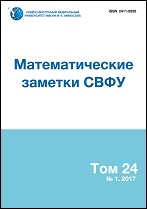|
Mathematical modeling
Computational experiment for identifying of cubic period of hexagonal diamond
I. E. Eremin, Den. V. Fomin
Department of Information and Control Systems, Amur State University, 21 Ignatievskoe Shosse, Blagoveshchensk 675000, Russia
Abstract:
The coefficient of compactness and the Madelung constant are key parameters in researches of substances in condensed state. The method of compact matrix description of crystal lattice makes calculation of these parameters faster and simpler. However, since this method is based on cubic symmetry of the crystal structure, it cannot be applied to substances of noncubic syngony.
In this paper, we study the crystal lattice of a hexagonal diamond to determine existence of the cubic period and cube-generator. The goals of our study are the following: 1) to determine the presence or absence of the cubic period and cube-generator of the crystal lattice; 2) to determine the space orientation of the cube-generator; 3) to determine the value of the cubic period; 4) to verify preservation of the discovered periodicity for an extensive crystal fragment.
The results of the computational experiment prove the existence of the cubic period and cube-generator. The value of the cubic period is obtained (36 notational units, $\sim$2,14 nm). Its preservation for an extensive crystal fragment is shown. It is shown that the space orientation of the cube-generator and basic elements of a two-component cubic model of the crystal lattice of the hexagonal diamond is the same.
The obtained results lead to applicability of the method of compact matrix description to the crystal lattice of the hexagonal diamond, thus optimizing the calculation of the compactness coefficient and the Madelung constant for this substance.
Keywords:
computational experiment, cubic period, crystal lattice model, hexagonal diamond, Lonsdaleite, compact matrix method, method of compact matrix description.
Received: 21.02.2019
Revised: 03.05.2019
Accepted: 03.06.2019
Citation:
I. E. Eremin, Den. V. Fomin, “Computational experiment for identifying of cubic period of hexagonal diamond”, Mathematical notes of NEFU, 26:2 (2019), 80–93
Linking options:
https://www.mathnet.ru/eng/svfu254 https://www.mathnet.ru/eng/svfu/v26/i2/p80
|

|




 Contact us:
Contact us: Terms of Use
Terms of Use
 Registration to the website
Registration to the website Logotypes
Logotypes








 Citation in format
Citation in format 